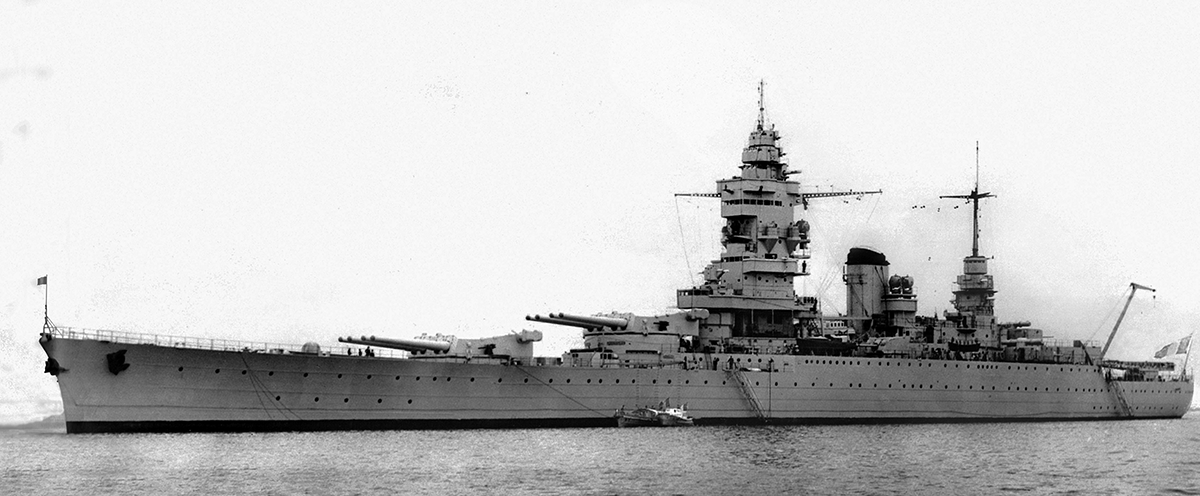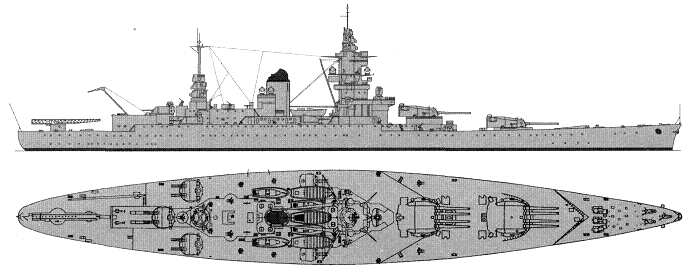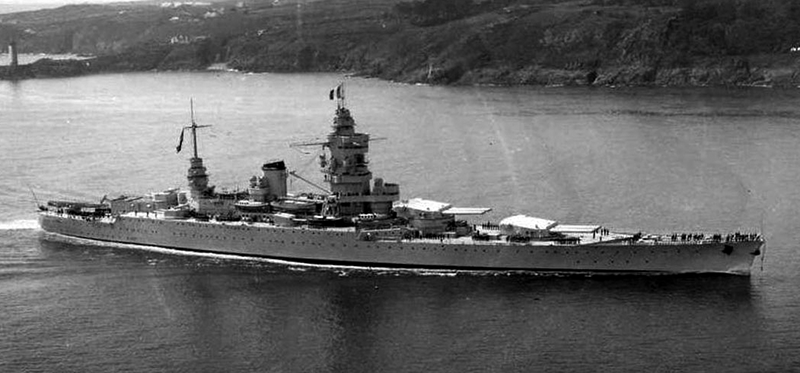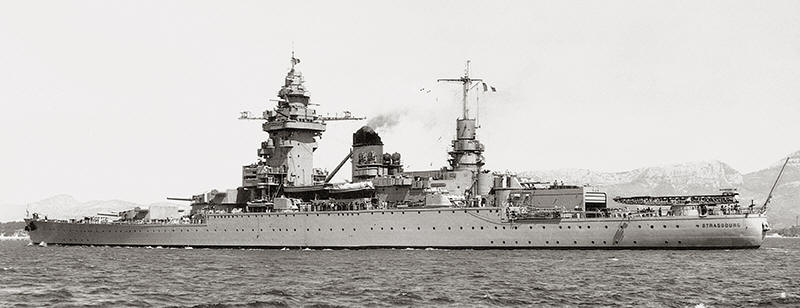
NAVYPEDIA
 Support the project with paypal
Support the project with paypal
Photo

Dunkerque 1938
Ships
| Name | No | Yard No | Builder | Laid down | Launched | Comp | Fate |
|---|---|---|---|---|---|---|---|
| Dunkerque | Arsenal de Brest | 24.12.1932 | 2.10.1935 | 1.5.1937 | scuttled 27.11.1942 | ||
| Strasbourg | E8 | A C de la Loire et Penhoët, St-Nazaire | 25.11.1934 | 12.12.1936 | 6.4.1939 | scuttled 27.11.1942 |
Technical data
| Displacement standard, t | Dunkerque: 26500 Strasbourg: 27300 |
|---|---|
| Displacement full, t | Dunkerque: 34884 Strasbourg: 36380 |
| Length, m | Dunkerque: 209.0 wl 215.1 oa Strasbourg: 209.0 wl 215.5 oa |
| Breadth, m | 31.1 |
| Draught, m | Dunkerque: 9.63 max Strasbourg: 9.82 max |
| No of shafts | 4 |
| Machinery | 4 sets Parsons geared steam turbines, 6 Indret boilers |
| Power, h. p. | Dunkerque: 110960 Strasbourg: 112000 |
| Max speed, kts | 29.5 |
| Fuel, t | Dunkerque: oil 5664 Strasbourg: oil 5948 |
| Endurance, nm(kts) | 16400(17) |
| Armour, mm | Dunkerque: belt: 225, torpedo bulkhead: 50 - 30, main deck: 130 - 115, lower deck: 40 with 50-mm slopes, turrets: 330 - 150, barbettes: 310, quadruple secondary turrets: 130 - 90, twin secondary turrets: 20, CT: 270 Strasbourg: belt: 283, torpedo bulkhead: 50 - 30, main deck: 130 - 115, lower deck: 40 with 50-mm slopes, turrets: 360 - 160, barbettes: 340, quadruple secondary turrets: 130 - 90, twin secondary turrets: 20, CT: 270 |
| Armament | Dunkerque: 2 x 4 - 330/52 M1931, 3 x 4 - 130/45 M1932, 2 x 2 - 130/45 M1932, 4 x 2 - 37/50 M1933, 3 seaplanes (CAMS 37, Loire 130, Potez 452, GL810, GL811, GL812, GL813, GL832, PL.15), 1 catapult Strasbourg: 2 x 4 - 330/52 M1931, 3 x 4 - 130/45 M1932, 2 x 2 - 130/45 M1932, 4 x 2 - 37/50 CAIL M1933, 5 x 4 - 13.2/76, 3 seaplanes (CAMS 37, Loire 130, Potez 452, GL810, GL811, GL812, GL813, GL832, Laté 298, PL.15), 1 catapult |
| Complement | 1431 |
Standard scale images

Strasbourg 1942

Dunkerque 1939

Strasbourg 1940
Graphics
Project history
First French capital ships constructed after WWI and the first-ever fast battleships, built under 1931 and 1934 programmes. They were intended for operations against German diesel-powered "Panzerschiffen" ("pocket battleships"). Characteristics of battleships were below limits, supposed by Washington and London Treaties. It was considered, that it should induce other countries to similar steps. For the first time capital ships received dual-purpose guns, and already on a design stage the aviation armament was provided. Often (and quite well-grounded), in view of rather light protection and high speed, they were referred to battlecruisers.
The scheme of main gun turrets placing and belt plates declination have been obviously borrowed at British battleships of Nelson class. At the same time French design was distinguished by application of quadruple main gun turrets. Their concentration in a bow was proved by that it allowed to shrink a length of an armoured citadel and, as consequence, economy of displacement, increased angles of horizontal aiming of turrets (the dead angle for 1st and 2nd main gun turrets astern was only 37° and 30° aboard respectively), simplified a fire control, the stern was exempted for aviation armament. Turrets were divided by a bulkhead on twin "semi-turrets", capable to operate independently. Ships had strong for their time DP and AA batteries though quadruple DP turrets calibre have very low turning and elevation rates, and to a beginning of war firing rate of 130mm guns was already insufficient for air defence.
Armoured belt had a declination outside in 11.3°, that ensured the resistibility equivalent of 283mm of the vertical protection. Besides, armour belt has been placed inside in the hull with filling of compartments behind an external plating by a water-resistant filler. Depth of underwater protection was up to 7m amidships and could resist close explosion of 300kg TNT. Minuses of the design were basically corollary of the limited displacement. Splinter protection was insufficient, some doubts were called by absence of counterflooding system. On Strasbourg protection was a little strengthened and fuel stowage was increased. Besides, she was differed by presence of one more level on the bridge.
Ship protection Dunkerque
11°inclined internal 225mm thick main belt covered area 126x5.75m, tapering to 125mm at lower edge. Its upper edge was connected with outside plating. Many small compartments between plating and belt were filled with special water-resistant material. Main belt was closed by 210mm fwd and 180mm aft bulkheads. Flat main deck laid on upper edge of main belt and had 125mm thickness over magazines and 115mm over machinery. Lower 40mm splinter deck connected with lower edge of main belt by 50mm slopes. Part of ship aft from citadel was protected by 100mm lower deck with 100mm slopes, closed by 100mm aft bulkhead of steering gear compartment. Main turrets had 330mm faces, 250mm sides, 345mm rears (for balancing) and 150mm roofs. Barbettes had 310mm armour on 30mm plating, but between armoured decks its thickness decreased to 50mm. Quadruple secondary turrets had 135mm faces, 90mm sides, 80mm rears, 90mm crowns; barbettes were 120mm. Twin secondary turrets had only 20mm protection. 7m-deep underwater protection was ended by 30mm torpedo bulkhead, its thickness increased to 40-50mm at ship ends.
Strasbourg
11°inclined internal 283mm thick main belt covered area 126x5.75m, tapering to 125mm at lower edge. Its upper edge was connected with outside plating. Many small compartments between plating and belt were filled with special water-resistant material. Main belt was closed by 210mm fwd and 180mm aft bulkheads. Flat main deck laid on upper edge of main belt and had 125mm thickness over magazines and 115mm over machinery. Lower 40mm splinter deck connected with lower edge of main belt by 50mm slopes. Part of ship aft from citadel was protected by 100mm lower deck with 100mm slopes, closed by 100mm aft bulkhead of steering gear compartment. Main turrets had 340mm faces, 250mm sides, 345mm rears (for balancing) and 160mm roofs. Barbettes had 340mm armour on 30mm plating, but between armoured decks its thickness decreased to 50mm. Quadruple secondary turrets had 135mm faces, 90mm sides, 80mm rears, 90mm crowns; barbettes were 120mm. Twin secondary turrets had only 20mm protection. 7m-deep underwater protection was ended by 30mm torpedo bulkhead, its thickness increased to 40-50mm at ship ends.
Modernizations 10.
1937, Dunkerque: + 6 x 4 - 13.2/76
5/1938, Dunkerque: - 4 x 2 - 37/50; + 2 x 4 - 13.2/76
2/1939, Dunkerque: + 4 x 2 - 37/50 M1933
summer 1939, Dunkerque: + 1 x 2 - 37/50 M1933
8/1939, Strasbourg: + 1 x 4 - 13.2/76
4/1942, Strasbourg: + 3 x 1 - 13.2/94, Sadir M.E.140 / M.E.126 radar
Naval service
In a beginning of war both battleships have headed the task force formed for intercept of "pocket battleships" in Atlantic. It was a unique case when these ships used as it was supposed at their creation. In the end of 1939 Dunkerque has transported to Canada 100t of gold: a payment for deliveries of the American military goods.
In April, 1940 both ships were passed to Mediterranean: France bore now liability for all this theatre. At the moment of armistice with Germany Dunkerque and Strasbourg were at Mers-el-Kebir. 3.7.1940 at "neutralisation" of French squadron by British force "H" Dunkerque was hard damaged (4 hits of 15`` shells) and ran aground. On July, 6th she received additional damages by explosion of DCs onboard patrol Terre-Neuve, torpedoed being moored aside. Strasbourg could break from the Mers-el-Kebir and on July, 4th arrived to Toulon.
At capture of Toulon by Germans both ships were destroyed by crews, thus Dunkerque was scuttled in dock. Italians salvaged Strasbourg 17.7.1943, but 18.8.1944 she was sunk by American bombers.
 HOME
HOME FIGHTING SHIPS OF THE WORLD
FIGHTING SHIPS OF THE WORLD FRANCE
FRANCE DUNKERQUE battlecruisers (1937 - 1939)
DUNKERQUE battlecruisers (1937 - 1939)





